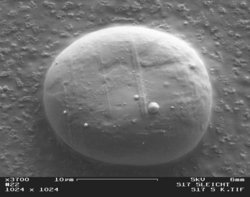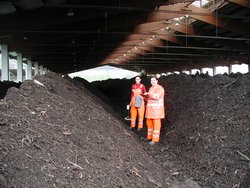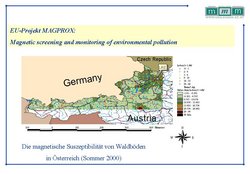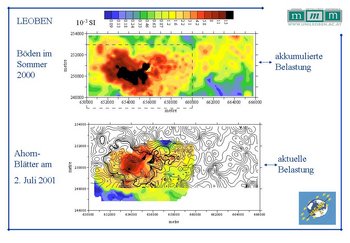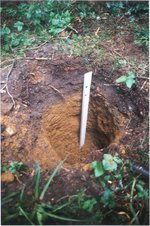Heavy metal indicators
Rock magnetic indicators for heavy metal concentrations in soils and sediment
Magnetic parameters are sensitive indicators for variations in the type, grain size and concentration of magnetic particles in soils and rocks. An essential advantage of the geophysical method is the possibility of a cost-efficient extension and condensation of information on environmental pollution.
Many heavy metal emissions are highly magnetic particles which can be quickly and clearly detected with the help of magnetic susceptibility and other parameters. Anthropogenic influence can increase the magnetic susceptibility of sediments and soils by a multiple of the natural magnitude. Examinations of soils and sediments show statistically significant connections between the magnetic susceptibility and certain heavy metal concentrations, in each case depending on the size and chemical composition of the particles responsible for the heavy metal anomaly. Especially in the case of particulate heavy metal input (dust, ashes, sludge) magnetic susceptibility can be used as an indicator for heavy metal contamination.
The measurement of magnetic susceptibility can be performed on any sample material in the laboratory as well as also directly on site. These examination methods have been successfully used for decades in interdisciplinary environmental research. With their help, contaminated horizons can be isolated and the extent of the accumulation can be estimated with relative ease.
IVUS: Identification of avoidable and unavoidable pollution sources using the example of the sewage plant Leoben (Reinhaltungsverband Leoben, Office of the Styrian Government within the framework of the EU regional funding, 2005-2007)
We determined magnetic parameters of samples of structural material, sewage sludge and compost from the sewage plant Leoben to examine their possible application as indicators for heavy metals which are environmentally relevant in the area of Leoben. The results of the magnetic examinations are in good agreement with those of the chemical analyses. We were able to discover a pronounced correlation between the analysed heavy metals and the magnetic parameters.
Magnetic measuring methods cannot replace chemical analyses and mineralogical examinations, but as an indicator for heavy metal emissions they constitute a quick and economic basis for evaluation.
Rock magnetic indicators for soil pollution (FWF P16314, 2003-2006)
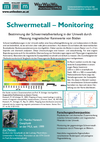
Magnetic measurements of soil samples of Austrian soil status inventories for the provinces of Carinthia, Styria, Burgenland, Lower and Upper Austria were used for the mapping of the magnetisability at different soil depths. The soils are not only influenced by emissions but also by natural magnetic minerals. The determination of natural normal values enables a transregional interpretation of such maps, which to date has only been possible with detailed knowledge of the geology and soil types of a research site.
MAGPROX: Screening and monitoring of anthropogenic pollution over central Europe by using MAGnetic PROXies (2000 - 2004)
In cooperation with three partner institutes in Germany, Poland and the Czech Republic we created transregional maps of the magnetic susceptibility of forest soil locations and examined the remote transportation of magnetic particles.
Partners:
- Geophysics Working Group, Institute of Geology and Paleontology, University of Tuebingen, Germany
- Geophysical Institute, Academy of Sciences of the Czech Republic, Prague, Czech Republic
- Institute of Environmental Engineering, Polish Academy of Sciences, Zabrze, Poland
MAG-NET: A European Network for Mineral Magnetic Studies of Environmental Problems (1999 - 2003)
Research network within the framework of the EU mobility programme for the investigation of the potential of mineral magnetic methods for environmental and climate research.
Partners:
- Lancaster University, UNITED KINGDOM
- University of Liverpool, UNITED KINGDOM
- Universidad Complutense Madrid, SPAIN
- CEREGE, Aix en Provence, FRANCE
- Ludwig-Maximilians-Universität München, GERMANY
- Istituto Nazionale di Geofisica, Roma, ITALY
- Utrecht University, THE NETHERLANDS
- Southampton Oceanography Centre, UNITED KINGDOM
- ETH Zürich, SWITZERLAND
SusMap: Application of geophysical measurement methods as economic indicators for geogenic and anthropogenic heavy metal accumulation in soils (Bund-Bundesländer-Kooperation, 1997-2000)
In cooperation with the Landwirtschaftlichen Versuchszentrum Steiermark, the aim of the project was to gain basic insights on the applicability of geophysical measurement methods for the planar detection of heavy metal accumulation in soils. The basis for the mapping of magnetic susceptibility were the measurements of all samples of the soil status inventories of the provinces of Styria, Lower Austria and Burgenland. The data pool contains 1254 sites with surface soil and subsoil samples, as well as 760 additional sites with surface soil samples.
The volume susceptibility was determined in the sample archives without opening the sample containers. For special laboratory measurements of the mass specific susceptibility, a representative number of test portions were retrieved. The determination of the characteristic magnetic parameters was carried out in the Magnetics Laboratory of the Montanuniversität. Virtually all anomalies of the susceptibility in the surface soil are simultaneously also areas with demonstrably increased heavy metal content. The difference in susceptibility between surface soil and subsoil is a measure for the accumulation of magnetic phases in certain horizons. The application of the method in the field was tried out in two test fields.
The anomaly patterns of the magnetic susceptibility show a general agreement with the prevailing wind direction and the valley axis. Based on the results from the test fields Veitsch and Leoben we were able to show that magnetic susceptibility mapping can be used as an economic method for the planar detection of industrial immissions.
Publications
Fran?iškovi?-Bilinski, S., Scholger, R., Bilinski, H., Tibljas, D. (2014): Magnetic, geochemical and mineralogical properties of sediments from karstic and flysch rivers of Croatia and Slovenia.
Environmental Earth Sciences, Vol. 72, 10: 3939-3953.
Fran?iškovi?-Bilinski, F., Bilinski, H., Scholger, R., Tomaši?, N. & Maldini, K. (2014): Magnetic spherules in sediments of the karstic Dobra River (Croatia).
Journal of Soils and Sediments, Vol. 14: 600-614.
Hanesch, M. (2009): Raman spectroscopy of iron oxides and (oxy)hydroxides at low laser power and possible applications in environmental magnetic studies.
Geophysical Journal International, Vol. 177: 941-948.
Hanesch, M., Rantitsch, G., Hemetsberger, S., Scholger, R. (2007): Lithological and pedological influences on the magnetic susceptibility of soil: Their consideration in magnetic pollution mapping.
Science of the Total Environment, Vol. 382: 351-363.
Maier, G., Scholger, R., Schön, J. (2006): The influence of soil moisture on magnetic susceptibility measurements.
Journal of Applied Geophysics, Vol. 59: 162-175.
Fialova, H., Maier, G., Petrovsky, E., Kapicka, A., Boyko, T., Scholger, R. & MAGPROX Team (2006): Magnetic properties of soils from different geological and environmental settings.
Journal of Applied Geophysics, Vol. 59: 273-283.
Hemetsberger, S. & Scholger, R. (2006): Umweltmagnetik im Raum Trofaiach bis Eisenerz (steirische Eisenstrasse).
Mitteilungen des naturwissenschaftlichen Vereins Steiermark, Band 135: 13-24, Graz.
Amereih, S., Meisel, T., Scholger, R., Wegscheider, W. (2005): Antimony speciation in soil samples along two Austrian motorways by HPLC-ID-ICP-MS.
Journal of Environmental Monitoring, Vol. 7: 1200-1206.
Hanesch, M. & Scholger, R. (2005): The influence of soil type on the magnetic susceptibility measured throughout soil profiles.
Geophysical Journal International, Vol. 161: 50-56.
Maier, G. & Scholger, R. (2004): Demonstration of connection between pollutant dispersal and atmospheric boundary layers by use of magnetic susceptibility mapping, St. Jacob (Austria).
Physics and Chemistry of the Earth, Vol. 29: 997-1009.
Boyko, T., Scholger, R., Stanjek, H. & MAGPROX-Team (2004): Topsoil magnetic susceptibility mapping as a tool for pollution monitoring: repeatability of in-situ measurements.
Journal of Applied Geophysics, Vol. 55 (3-4): 249-259.
Hanesch, M., Scholger, R., Rey, D. (2003): Mapping dust distribution around an industrial site by measuring magnetic parameters of tree leaves.
Atmospheric Environment, Vol. 37: 5125-5133.
Hanesch, M. & Scholger, R. (2002): Mapping of heavy metal loadings in soils by means of magnetic susceptibility measurements.
Environmental Geology, Vol. 42: 857-870.
Sager, M. & Scholger, R. (2002): Magnetic Susceptibility Measurements as a Rapid Screening Method for Fertilizers.
Journal of the Korean Institute of Mineral and Energy Resources Engineers, Vol. 39, 5: 307-313, Seoul.
Schibler, L., Boyko, T., Ferdyn, M., Gajda, B., Höll, S., Jordanova, N., Rösler, W. and MAGPROX-TEAM (2002): Topsoil magnetic susceptibility mapping: Data reproducibility and compatibility, measurement strategy.
Studia Geophysica et Geodaetica, Vol. 46: 43-57, Prague.
Hanesch, M., Scholger, R. & Dekkers, M. (2001): The Application of Fuzzy C-Means Cluster Analysis and Non-Linear Mapping to a Soil Data Set for the Detection of Polluted Sites.
Physics and Chemistry of the Earth (A), Vol. 26, 11-12: 885-891.
Hanesch, M. & Scholger, R. (2000): Analysis of heavy metal pollution in soils by means of non linear mapping and fuzzy C-means cluster analysis.
Geologica Carpathica, Vol. 51, 3: 198-199, Bratislava.
Bityukova, L., Scholger, R., Birke, M. (1999): Magnetic susceptibilty as indicator of environmental pollution of soils in Tallinn (Estonia).
Physics and Chemistry of the Earth (A), Vol. 24, 9: 829-835.
Scholger, R. (1998): Heavy metal pollution monitoring by magnetic susceptibility measurements applied to sediments of the river Mur (Styria, Austria).
European Journal of Environmental and Engineering Geophysics, Vol. 3: 25-37.
